Atari 2600
|
| |
 Atari VCS four-switch "wood veneer" version, dating from 1980 to 1982 | |
| Also known as | Atari VCS (before November 1982) |
|---|---|
| Manufacturer | Atari, Inc. |
| Type | Home video game console |
| Generation | Second Generation |
| Release date |
|
| Retail availability | 1977–1992 |
| Introductory price | US$199 (equivalent to $803.65 in 2017) |
| Discontinued | January 1, 1992[1] |
| Units sold | 30 million (As of 2004)[2] |
| Media | ROM cartridge |
| CPU | 8-bit MOS Technology 6507 @ 1.19 MHz |
| Memory | 128 bytes RAM |
| Controller input |
Joystick Paddles Driving Controller Trak-Ball Keypad |
| Best-selling game | Pac-Man, 7 million (As of September 1, 2006)[3][4] |
| Predecessor | Atari Pong |
| Successor | Atari 8-bit family / Atari 5200 |
The Atari 2600 (or Atari Video Computer System or Atari VCS before November 1982) is a home video game console from Atari, Inc. Released on September 11, 1977, it is credited with popularizing the use of microprocessor-based hardware and games contained on ROM cartridges, a format first used with the Fairchild Channel F in 1976. This contrasts with the older model of having dedicated hardware that could play only those games that were physically built into the unit. The 2600 was bundled with two joystick controllers, a conjoined pair of paddle controllers, and a game cartridge: initially Combat,[5] and later Pac-Man.[6]
Entering 1975, Atari was already successful with its arcade games and dedicated home consoles that recreated these games (such as Pong), but there were increasing costs and risks in these adaptations. The company wanted to push for a home console that could play multiple games, necessitating a microprocessor which were still costly. Breadboard development of this system, nicknamed "Stella", coincided with the release of the MOS Technology 6502 microprocessor, one of the first low-cost processors to hit the market; Atari worked with MOS Technology and established the use of their less-powerful MOS Technology 6507 for the platform. Further, Atari's Jay Miner led development of the Television Interface Adapter (TIA) chip which performed all the graphics and audio output to the television display necessary for the platform. These were coupled with the necessary input/output ports with a ROM cartridge reader and joystick controllers to complete the system. Atari's system was still in development when the Fairchild Channel F was announced, leading Atari's owner Nolan Bushnell to sell Atari to Warner Communications in 1976, in exchange for a cash infusion to speed up development. Initial production for the console's November 1977 release was made at Atari's Sunnyvale, California location while future units were produced in Hong Kong.
The Atari 2600 sold moderately well in its first few years, relying principally on ports of arcade games, both from Atari and titles licensed from others. Disagreements over sales potential of the 2600 led Bushnell to leave Atari in 1979. Following the release of Atari's licensed version of Space Invaders from Taito in 1980, the 2600 became widely successful, leading to the creation of third-party game developers, notably Activision, and competition from other home console makers such as Coleco and Mattel Electronics by 1982. Atari invested heavily in two games for the 2600, Pac-Man and E.T. the Extra-Terrestrial, that would become commercial failures for Atari and contributed to the video game crash of 1983. The 2600 was shelved as the industry recovered, while Warner sold off the home console division of Atari to Commodore. The new Atari Corporation under Commodore re-released a low-cost streamlined version of the 2600 in 1986, as well as the Atari 7800 that boosted backwards compatibility with the 2600. Ultimately, production of the Atari 2600 and other home consoles ended in 1992, with an estimated 30 million units of the 2600 sold as of 2004.
History
Atari was founded by Nolan Bushnell and Ted Dabney of which their first major product was Pong in 1972, one of the first successful arcade games.[7] It transitioned Pong into a home console version by 1975, helping to pit Atari against Magnavox, the only other major competitor for home consoles at the time. Bushnell recognized that this approach to home consoles has a drawback in that because it used custom logic burned onto the circuit board, it was limited to only one game and any variants, and would require consumers to buy another console to play a different set of games.[8] Further, while they could continue to take games they had created for arcade machines to home consoles, this development step cost at least US$100,000 and time to complete, and once on the market, had only about a three-month shelf life before being outdated, making this a risky move.[9]
In 1974, Atari had acquired Cyan Engineering, an electronics company founded by Steve Mayer and Larry Emmons, both former colleagues of Bushnell and Dabney from Ampex, and started Atari's Grass Valley Think Tank, where they were involved with coming up with new ideas for arcade games. Based on Bushnell's concern about single-game consoles, the Grass Valley team started working on how to achieve a home console with multi-game support. Mayer and Emmons recognized that to achieve a home console with multiple game functionality, they would need newly-invented microprocessors within the console, but at that time, such microprocessors costed from US$100-300, far outside the range that their market would support.[8] In September 1975, Chuck Peddle of MOS Technology had created a low-cost replacement for the Motorola 6800, the MOS Technology 6502, which they introduced at the 1975 Wescon trade show in San Francisco. Mayer and Ron Milner attended the show, met with Peddle, and later invited Peddle to Cyan's headquarters to discuss using MOS's microprocessors for a game console. Mayer and Milner had been able to negotiate purchase of the 6502 chips for US$8 a piece, sufficient to begin development of a console.[9] Through their discussions, Cyan and MOS decided that the better solution would be the MOS Technology 6507, which was a more restrictive but lower-cost version of the 6502. Cyan and MOS also arranged to bring in Synertek, a semiconductor manufacturer whose co-founder, Bob Schreiner, was good friends with Peddle, to act as a second source for the 6507.[8]
By December 1975, Atari hired Joe Decuir to help design the first prototype around the 6502, which was codenamed "Stella", the name of Decuir's bicycle.[9] S second prototype had been completed by March 1976 with the help of Jay Miner, who had been able to squeeze an entire wire wrap of equipment making up the Television Interface Adaptor (TIA), sending graphics and audio to the television display, into a single chip.[10] The second prototype includied the 6507, tthe TIA, and a ROM cartridge slot and adapter, each cartridge holding a ROM image of a game.[9] Believing that "Stella" would be a success, Bushnell acquired the entire Grass Valley Think Tank and relocated them into Atari's new headquarters in Sunnyvale, California by mid-1986, putting Steve Mayer in charge of the project.[9] Bushnell also feared that once this unit was released, other competitors on the market would try to copy it, and pre-emotively made arrangements with all integrated chip manufacturers that had interest in the games market to deny sales to his competitors.[9]
Fairchild Semiconductor introduced its Fairchild Channel F home console in November 1976, which including ROM cartridge technology, beating Atari to the market. The company was pressured to finish the unit as fast as possible, but lacked the funds to do so. Bushnell had considered taking Atari public but instead decided to sell the company to Warner Communications for US$28 million, and subsequently Warner provided around US$100 million into Atari, allowing them to prioritize and fast-track "Stella".[9] By 1977, the product had advanced far enough to brand it as the "Atari Video Computer System" (VCS) and engage Atari's programmers to develop games for it.[9]
The unit was showcased in mid-1977 at the Summer Consumer Electronics Show with plans for retail release in October.[9] However, Atari encounters a number of production problems during its first batch, with testing of each system complicated by the use of cartridges. Ultimately, the consoles were shipped to retailers in November 1977.[9]
Launch and success
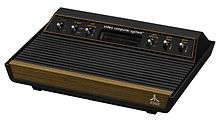
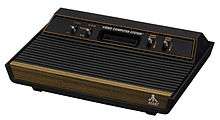
At release in September 1977, the unit was originally priced at US$199 ($804 adjusted for inflation), and shipped with two joysticks and a Combat cartridge (eight additional games were available at launch and sold separately).[11] Atari sold between 350,000 and 400,000 Atari VCS units during 1977, attributed to the delay in shipping the units and consumers' uncertainty about the console compared to the dedicated Pong consoles.[12]
Production for 1978 was outsourced to Hong Kong, producing about 800,000 units; however, sales of the VCS were still seen as slow, with only 550,000 sold by year's end. This required further financial support from Warner to cover losses, ultimately leading Bushnell to leave the company in 1978.[12]
Despite Bushnell's retirement in 1978, Warren Robinett's invention of the first action-adventure game, Adventure, was developed the same year and changed the fundamentals of gaming as it unlocked a game with a "virtual space bigger than the screen".[13] However, the VCS still yet had gained a killer application to sell the console, and it had suffered the loss of programmers David Crane, Bob Whitehead, Larry Kaplan, and Alan Miller, the company's "Fantastic Four" whom had programmed most of the successful VCS games to that point. The four left Atari disgruntled over Warner's oversight of the company and treatment of programmers in 1978, and formed their own firm Activision which would give rise to third-party software for the VCS.[12] While the VCS was the best-selling console during the 1979 holiday season with over 1 million units sold, Atari saw newfound competition from the Mattel Intellivision and Magnavox Odyssey², both systems that also used swapable ROM cartridges.[14]
Atari then licensed the arcade hit Space Invaders by Taito, which greatly increased the unit's popularity when it was released in January 1980, doubling sales to over 2 million units. The VCS and its cartridges were the main factor behind Atari grossing more than $2 billion in 1980.[12] Sales then doubled again for the next two years; by 1982, the console had sold 10 million units, while its best-selling game Pac-Man sold 7 million copies.[15] The console also sold 450,000 units in West Germany by 1984.[16]
In 1982, Atari launched its second home console, which it named the Atari 5200; to standardize its naming, the VCS was renamed to the "Atari 2600 Video Computer System", or "Atari 2600" for short, with the 2600 being derived from the manufacture part number CX2600.[17] By 1982 the 2600 console cost Atari about $40 to make and was sold for an average of $125. The company spent $4.50 to $6 to manufacture each cartridge and $1 to $2 for advertising, and sold it for $18.95 wholesale.[18]
Third party development
Activision, formed by four former Atari VCS programmers, started developing third-party games to be used on cartridge systems, including the VCS, starting in 1979. Atari to legal action to block sale of the Activision cartridges, but failed, allowing other third party game developers for the VCS to flourish.[19][20][21]
Another similar situation was around Rob Fulop, who had developed the VCS version of Missile Command that went on to sell over 2 million copies.[22] Atari rewarded him with a certificate for a free turkey for this milestone, prompting him to leave Atari.[23] Fulop co-founded Imagic, with his first game for the company, Demon Attack, becoming a hit in 1982. Other VCS-focused game development companies that sprang up in the early 1980s include US Games, Telesys, Games by Apollo, Data Age, Zimag, Mystique, and CommaVid. Mattel and Coleco, each already producing its own more advanced console, created simplified versions of existing titles for the 2600. Mattel used the M Network brand name for its cartridges. Third-party titles competed with Atari's share of VCS games, only having about half of VCS game sales by 1982.[24]
Decline and Redesign
Atari continued to acquire licenses for the 2600, the most prominent of which included Pac-Man—which critics slammed as "Flicker-Man"[25]—and E.T. the Extra-Terrestrial, which was designed and programmed in six weeks.[25] Public disappointment with these two games and the market saturation of poor third-party titles are cited as triggers for the video game crash of 1983. In September 1983, Atari buried 14 truckloads of cartridges and other equipment in the New Mexico desert;[26] an event later labeled the Atari video game burial. Warner quickly grew tired of supporting Atari, and started looking for buyers in 1984.
By mid-1984 most software development for the 2600 had stopped except by Atari and Activision.[27] The 2600 was de-emphasized for two years after Warner's 1984 sale of Atari, Inc.'s Consumer Division to Commodore founder Jack Tramiel, who wanted to concentrate on home computers. He ended all development of console games.
In 1986 Atari Corporation released a redesigned model of the 2600, supported by an ad campaign touting a price of "under 50 bucks."[28] The same year, Atari also introduced the Atari 7800 ProSystem, a third generation console backward compatible with 2600 cartridges. With a large library of games and a low price point, the 2600 continued to sell into the late 1980s. Atari released a final batch of titles in 1989-90 including Secret Quest [29] and Fatal Run.[30] The final Atari-licensed release is the PAL-only port of the arcade game KLAX in 1990.
After over 14 years on the market, the 2600 line was formally discontinued on January 1, 1992,[31] along with the Atari 7800 and Atari 8-bit computers.
Hardware
Console
The Atari 2600's CPU is the MOS Technology 6507, a version of the 6502,[32] running at 1.19 MHz in the 2600.[33] Though their internal silicon was identical, the 6507 was cheaper than the 6502 because its package included fewer memory-address pins—13 instead of 16.[34] The designers of the Atari 2600 selected an inexpensive cartridge interface[35] that had one fewer address than the 13 allowed by the 6507, further reducing the already limited addressable memory to 4 kB (212 = 4096). This was believed to be sufficient as Combat was itself only 2 kB.[36] Later games get around this limitation with bank switching.[37] The maximum supported cartridge size is 32 kilobytes.[38]
The console has only 128 bytes of RAM for scratch space, the call stack, and the state of the game world.
The top bezel of the cast included either six or four (in later revisions) switches, which included the power switch, TV type selection, game selection, player difficulty switches, and game reset switches. The difficulty switches were moved to the back of the top bezel in later revisions. The back bezel also includes the ports for controllers, television output, and power adapter outlets.
Graphics
The 2600 did not use a frame buffer. Instead the video device uses two bitmapped sprites: two 1-pixel "missile" sprites, a 1-pixel "ball", and a 40-pixel "playfield" that is drawn by writing a bit pattern for each line into a register just before the television scans that line. As each line is scanned, a game must identify the non-sprite objects that overlaps the next line, assemble the appropriate bit patterns to draw for those objects, and write the pattern into the register. Similar to its predecessor Pong, the right side of the screen is a mirrored duplicate of the left; to control it separately, the software may modify the patterns as the scan line is drawn. After the controller scans the last active line, a slower vertical blanking interval begins, during which the game can process inputs and update the positions and states of objects in the game world. Any mistake in timing produces visual artifacts, a problem that programmers call "racing the beam".[39]
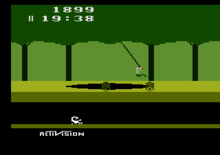
The 2600's video hardware is therefore highly flexible, but also challenging to program. One advantage the 2600 has over more powerful contemporary competitors such as the ColecoVision is that the 2600 has no protection against altering settings in mid-line. For example, although each sprite nominally has only one color, it is possible to color the rows differently by changing the sprite's color as it is drawn. If the two hardware sprites are not enough for a game, a developer may share one sprite among several objects (as with the ghosts in Pac-Man) or draw software sprites, which is only a little more difficult than drawing a fixed playfield. The Pitfall! screenshot demonstrates some of these tricks: the player is a multi-color sprite, one sprite is multiplexed for the logs and the scorpion, and the swinging vine is drawn by shifting the position of the "ball" on each scan line.[40] Warren Robinett, the programmer for Adventure, described numerous tricks that he had to do to complete adventure to both fit it within the memory limitations of the Atari 2600, as well as use creatively use the graphics capability to create a multi-screen maze for players to navigate, using the "missile" sprite to create the maze's walls.[41]
Atari established their system design in order to be compatible with the cathode-ray tube television sets in the late 1970s and early 1980s.[42] The Atari 2600 uses different color palettes depending on the television signal format used.[43] With the NTSC format, a 128-color palette is available,[44] while in PAL, only 104 colors are available.[43] Additionally, the SECAM palette consists of only 8 colors.[43]
A side effect of how graphics work on the 2600 is that all games are required to run at either 60 frames per second (NTSC) or 50 frames per second (PAL).
Controllers
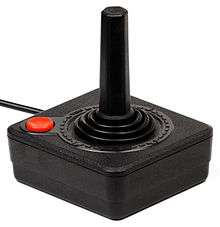
The VCS originally shipped with two types of controllers: a joystick (part number CX10) and pair of rotary paddle controllers (CX30). Driving controllers, which are similar to paddle controllers but can be continuously rotated, shipped with the Indy 500 launch title. After less than a year, the CX10 joystick was replaced with the CX40 model[45] designed by James C. Asher.[46] Because the Atari joystick port and CX40 joystick became industry standards, 2600 joysticks and some other peripherals work with later systems, including MSX, Commodore 64, Amiga, Atari 8-bit family, and Atari ST. The CX40 joystick can be used with the Master System, and Sega Genesis, but does not provide all the buttons of a native controller. Third-party controllers include Wico's Command Control joystick.[47]
Atari introduced the CX50 Keyboard Controller in June 1978, along with two games that required it: Codebreaker and Hunt & Score.[45] The CX22 Trak-Ball controller was announced in January 1983 and was compatible with the Atari 8-bit family.[48]
Console models
Minor revisions
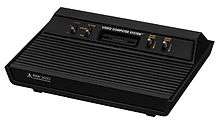
The initial production of the VCS was made in Sunnyvale, using thick plastic for the casing, and with all six console switches on the front panel. Production of the unit was moved to Hong Kong in 1979, where a thinner plastic was used for the casing, reducing the system's weight. These two versions are commonly referred to as "Heavy Sixers" and "Light Sixers" respectively, representing the six front switches.[49]
In 1980, the VCS was given an update in which the left and right difficulty switches were moved to the back of the console, leaving four switches on the front. Other than this, these four-switch consoles looked nearly identical to the earlier six-switch models. In 1982 Atari rebranded the console as the "Atari 2600," a name first used on a version of the four-switch model without woodgrain, giving it an all black appearance.
Sears Tele-Games
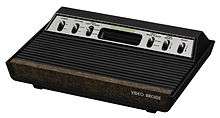
Atari continued their OEM relationship with Sears under the latter's Tele-Games brand, which started in 1975 with the original Pong. (The company Telegames, which later produced cartridges for the 2600, is unrelated.)[50] Sears released several models of the VCS as the Sears Video Arcade series starting in 1977. In 1983, the previously Japan-only Atari 2800 was rebranded as the Sears Video Arcade II.[51]
Sears released versions of Atari's games with Tele-Games branding, usually with different titles.[52] Three games were produced by Atari for Sears as exclusive releases: Steeplechase, Stellar Track, and Submarine Commander.[52]
Atari 2800
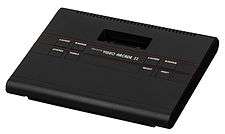
The Atari 2800 is the Japanese version of the 2600 released in October 1983. It was the first release of a 2600 designed specifically for the Japanese market, despite companies like Epoch distributing the 2600 in Japan previously. It was released a short time after Nintendo's Family Computer, which became the dominant console in Japan, and the 2800 did not gain a significant share of the market. Sears released the 2800 in the US in 1983 as the Sears Video Arcade II packaged with two controllers and Space Invaders.[53] Around 30 specially branded games were released for the 2800.
Designed by engineer Joe Tilly, the 2800 has four controller ports instead of the two of the 2600. The controllers are an all-in one design using a combination of an 8-direction digital joystick and a 270-degree paddle, designed by John Amber.[53] The 2800's case design departed from the 2600, using a wedge shape with non-protruding switches. The case style was used as the basis for the Atari 7800's case designed by Barney Huang.[53]
Atari 2600 Jr.
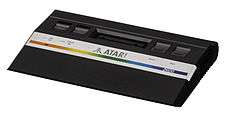
The 1986 model, unofficially referred to as the 2600 Jr., features a smaller, cost-reduced form factor with a modernized, Atari 7800-like appearance. The redesigned 2600 was advertised as a budget gaming system (under US$49.99) that has the ability to run a large collection of classic games.[54] Though released after the video game crash of 1983, and after the North American launch of the Nintendo Entertainment System, the 2600 was supported with new games and television commercials promoting "The fun is back!" Later European versions of the 2600 Jr. include a joypad, which is also featured with the European 7800. Atari released several minor stylistic variations of the 2600 Jr. design: the "large rainbow" (shown at right), "short rainbow," and an all-black version sold only in Ireland.[55]
Games
In 1977, nine games were released on cartridge to accompany the launch of the machine, including Air-Sea Battle, Star Ship and Street Racer.[56] During the console's lifetime, Atari, Inc. and Atari Corp. published many titles: these games included Adventure (often credited as starting the action-adventure game genre),[57] Breakout,[58] and Yars' Revenge.[59]
Rick Maurer's port of Taito's Space Invaders, released in 1980, was the first VCS title to sell over a million copies—eventually doubling that.[60] It became the killer app to drive console sales. Versions of Atari's own Asteroids and Missile Command arcade games, released the following year, were also major hits.
Two Atari published titles, both from 1982, E.T. the Extra-Terrestrial[61] and Pac-Man,[62] are frequently blamed for contributing to the video game crash of 1983. To clear inventory and save money in wake of the crash, Atari shipped about 700,000 Atari 2600 games, including unsold lots of Pac-Man and E.T., to a landfill in Alamogordo, New Mexico in 1983. Until 2014, there was skepticism of how much Atari had buried there, in some cases estimates of millions of cartridges, creating an urban legend of an Atari video game burial. The legend was proven out in 2014 when interested parties were able to dig up a portion of a landfill, confirmed its contents of unsold Atari games.
Atari suffered from an image problem when a company named Mystique produced a number of pornographic games for the 2600. The most notorious of these, Custer's Revenge, was protested by women's and Native American groups[63] because it depicted General George Armstrong Custer raping a bound Native American woman.[64] Atari sued Mystique in court over the release of the game.[65]
Legacy
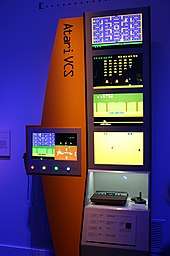
The Atari VCS—and later as the 2600—was wildly successful in the late 1970s and early 1980s, to where "Atari" was a synonym for the system in mainstream media and, by extension, for video games in general.[66]
Jay Miner directed the creation of the successors to the 2600's TIA chip—CTIA and ANTIC—which were central to the Atari 8-bit computers released in 1979.
The Atari 2600 was inducted into the National Toy Hall of Fame at The Strong in Rochester, New York, in 2007.[67] In 2009, the Atari 2600 was named the number two console of all time by IGN, who cited its remarkable role as the console behind both the first video game boom and the video game crash of 1983, and called it "the console that our entire industry is built upon".[68]
Clones and reissues
Modern Atari 2600 clones remain on the market. The Atari Classics 10-in-1 TV Game, manufactured by Jakks Pacific, emulates the 2600 console and includes converted versions of 10 games into a single Atari-brand-lookalike joystick with composite-video outputs for connecting directly to modern televisions or VCRs. The TV Boy includes 127 games in an enlarged joypad.
The Atari Flashback 2 console, released in 2005, contains 40 games (with four additional programs unlockable by a cheat code). The console implements the original 2600 architecture and can be modified to play original 2600 cartridges by adding a cartridge port, and is also compatible with original 2600 controllers.
In 2017, Hyperkin announced the RetroN 77, a clone of the Atari 2600 that plays original cartridges instead pre-installed games.[69]
The Atari VCS microconsole, planned for release from Atari Interactive by 2019, is designed on a miniaturization of the Atari 2600, including the option for its faux wood paneling. This microconsole is designed to play several Atari 2600 games under emulation on a Linux operating system, as well as potentially other games for computers and other gaming systems.
Unreleased prototypes
Atari 2700
The Atari 2700 was a version of the 2600 using wireless controllers.
Atari 2000
The Atari 2000 (model number CX-2000) was a version of the Atari 2600 intended to be released as a cheaper alternative in 1982. Although identical in specification to the original 2600, the 2000 included built-in controllers and an unusual case design originally intended to be black, but later recolored blue. The project was halted in favor of the Atari 2600 Jr.[70]
Atari 3200
Atari started work on a replacement to the 2600, called the Atari 3200. It was to be compatible with 2600 cartridges, and was rumored to be based on a 10-bit processor, although design documents shows it was to actually be based around the 8-bit 6502. It was still unfinished when preliminary game programmers discovered that it was difficult to program. Atari cloned the Atari 3200 into the Sears Super Arcade II, but this was never released.[71]
See also
References
- ↑ Monfort, Nick & Bogost, Ian (2009). Racing the Beam. MIT Press. p. 150.
- ↑ "A Brief History of Game Console Warfare | BusinessWeek". 2007-05-09. Retrieved 2018-10-13.
- ↑ Jeremy Reimer (September 1, 2006). "EA's Madden 2007 sells briskly, but are games gaining on movies?". Ars Technica. Archived from the original on February 23, 2008. Retrieved January 31, 2008.
- ↑ Kent, Steven (2001). The Ultimate History of Video Games. Three Rivers Press. ISBN 0-7615-3643-4.
- ↑ Weesner, Jason (January 11, 2007). "On Game Design: A History of Video Games". Retrieved November 13, 2007.
- ↑ "Image of box with Pac-Man sticker".
- ↑ Chafkin, Max (April 1, 2009). "Nolan Busnell is Back in the Game". Inc. Retrieved September 11, 2018.
- 1 2 3 Goldberg, Marty (January 4, 2008). "The 2600 Story - Part I". GameSpy. Archived from the original on October 13, 2013. Retrieved September 11, 2018.
- 1 2 3 4 5 6 7 8 9 10 Fulton, Steve (November 6, 2007). "The History of Atari: 1971-1977". Gamasutra. Retrieved September 11, 2018.
- ↑ Curt Vendel. "The Atari VCS Prototype". Atarimuseum.com. Archived from the original on January 17, 2013. Retrieved March 30, 2014.
- ↑ Forster, Winnie (2005). The encyclopedia of consoles, handhelds & home computers 1972-2005. GAMEPLAN. p. 27. ISBN 3-00-015359-4.
- 1 2 3 4 Fulton, Steve (August 21, 2008). "Atari: The Golden Years -- A History, 1978-1981". Gamasutra. Retrieved September 11, 2018.
- ↑ Monfort, Nick & Bogost, Ian (2009). Racing The Beam. MIT Press. p. 18.
- ↑ Russell, Jimmy (December 3, 2012). 101 Amazing Atari 2600 Facts. Andrews UK Limited. ISBN 9781782344957.
- ↑ Guinness World Records Gamer's Edition. Guinness World Records. 2008. p. 24. ISBN 1-904994-21-0.
10 million - number of Atari 2600 consoles sold by 1982. 7 million - estimated number of copies of Pac-Man for the Atari 2600 sold.
- ↑ "EG Goes Continental: Europe Joins the Game World". Electronic Games. Vol. 2 no. 23. January 1984. pp. 46–7. Retrieved February 5, 2012.
- ↑ Barton, Matt; Loguidice, Bill (February 28, 2008). "A History of Gaming Platforms: Atari 2600 Video Computer System/VCS". Gamasutra. Retrieved September 11, 2018.
- ↑ Hubner, John; Kistner, William F. Jr. (November 28, 1983). "What went wrong at Atari?". InfoWorld. San Jose Mercury News. p. 151. Retrieved March 5, 2012.
- ↑ "Atari Sues to k.o. Competition". InfoWorld. August 4, 1980. p. 1. Retrieved March 30, 2014.
- ↑ John Markoff (December 21, 1981). "Atari attempts to gobble software competition". InfoWorld. p. 1. Retrieved March 30, 2014.
- ↑ Mark P. Wolf (2012). Encyclopedia of Video Games: The Culture, Technology, and Art of Gaming. 2. ABC-CLIO. p. 6. ISBN 9780313379369. Retrieved March 30, 2014.
- ↑ Buchanan, Levi (August 26, 2008). "Top 10 Best-Selling Atari 2600 Games". IGN.
- ↑ "Atari VCS/2600 FAQ". Atari Compendium.
- ↑ Rosenberg, Ron (December 11, 1982). "Competitors Claim Role in Warner Setback". The Boston Globe. p. 1. Retrieved March 6, 2012.
- 1 2 Crawford, Chris (1991). "The Atari Years". The Journal of Computer Game Design. 5.
- ↑ "Atari Parts Are Dumped". New York Times. 1983.
- ↑ Holyoak, Craig (May 30, 1984). "Here are ColecoVision's jewels". Deseret News. pp. 4 WV. Retrieved January 10, 2015.
- ↑ "Atari 2600 1986 Commercial "The Fun is Back"". YouTube.
- ↑ "Secret Quest". Atari Mania.
- ↑ "Fatal Run". Atari Mania.
- ↑ Monfort, Nick & Bogost, Ian (2009). Racing the Beam. MIT Press. p. 150.
- ↑ "When Pac Ruled the Earth". Electronic Gaming Monthly (62). EGM Media, LLC. September 1994. p. 18.
- ↑ Stewart, Keith (February 24, 2017). "10 most influential games consoles – in pictures". The Guardian. Retrieved September 17, 2018.
- ↑ Monfort, Nick & Bogost, Ian (2009). Racing the Beam: The Atari Video Computer System. MIT Press. p. 25. ISBN 0-262-01257-X.
- ↑ The cartridge connector's 24 pins are allocated to one supply-voltage line, two ground lines, 8 data lines, and 13 address lines. The uppermost address line is used as a so-called chip select for the cartridge's ROM chip, however, leaving only 12 address lines for the chip's game program. Thus, without special "hardware tricks" built into the cartridge, an Atari 2600 game can occupy a maximum address space of 4 kB. Monfort, Nick & Bogost, Ian (2009). Racing the Beam: The Atari Video Computer System. MIT Press. p. 26. ISBN 0-262-01257-X.
- ↑ Monfort, Nick & Bogost, Ian (2009). Racing the Beam: The Atari Video Computer System. MIT Press. pp. 25–26. ISBN 0-262-01257-X.
- ↑ Monfort, Nick & Bogost, Ian (2009). Racing the Beam: The Atari Video Computer System. MIT Press. p. 88. ISBN 0-262-01257-X.
- ↑ "Neo Geo CD Brings Arcade Home". Electronic Gaming Monthly (61). EGM Media, LLC. August 1994. p. 60.
- ↑ Bogost, Ian; Montfort, Nick (2009). Racing the Beam: The Atari Video Computer System. MIT Press. ISBN 0-262-01257-X.
- ↑ "GDC 2011 Panel: Pitfall Classic Postmortem With David Crane". GDC Vault. Retrieved June 23, 2013.
- ↑ Bogost, Montfort 2009, p. 52.
- ↑ Arceneaux, Noah (2015). "Game theories, technologies and techniques of play". sagepub.co.uk/journalsPermission.nav.
- 1 2 3 Atari 2600 "TIA color chart" Archived February 12, 2011, at WebCite.
- ↑ "What is RGB colour?". Retrieved March 12, 2014.
- 1 2 Current, Michael A. "A History of WCI Games / Atari / Atari Games / Atari Holdings".
- ↑ "United States Patent 4,349,708" (PDF). September 14, 1982.
- ↑ "Gamertell Review: Wico's Command Control Joystick".
- ↑ Current, Michael D. "Atari 8-Bit Computers FAQ".
- ↑ Beaudoin, Dave (May 31, 2016). "You Can Judge a 2600 By Its Cover". Digital Game Museum. Retrieved September 11, 2018.
- ↑ Yarusso, Albert. "Catalog: Telegames". AtariAge. Retrieved August 31, 2010.
- ↑ Yarusso, Albert. "AtariAge - 2600 Consoles and Clones". AtariAge. Archived from the original on October 6, 2007. Retrieved October 7, 2007.
- 1 2 Yarusso, Albert. "Atari 2600 - Sears — Picture Label Variation". AtariAge. Retrieved October 7, 2007.
- 1 2 3 Vendel, Curt. "The Atari 2800 System". arquivo.pt. Archived from the original on May 23, 2016.
- ↑ "Atari 7800 and 2600". Sears Catalog. 1988.
- ↑ "2600 Consoles and Clones". Retrieved August 2, 2018.
- ↑ "Video Games Console Library Atari VCS Launch Titles". Retrieved September 8, 2017.
- ↑ Robinett, Warren. "Adventure for the Atari 2600 Video Game Console". Archived from the original on October 25, 2007. Retrieved October 11, 2007.
- ↑ "Breakout for Atari 2600 (1978) - MobyGames". MobyGames. Retrieved November 29, 2015.
- ↑ Rittmeyer, Brian C. "The Essential 2600 Games". The Atari Times. Archived from the original on October 29, 2007. Retrieved November 8, 2007.
- ↑ Kevin Day, Patrick (January 22, 2013). "Atari bankruptcy: Remembering the 2600, 7 bestselling games". Hero Complex.
- ↑ Parish, Jeremy. "Classic 1UP.Com's Essential 50". 1UP.Com. Retrieved November 8, 2007.
- ↑ Vendel, Curt. "The Atari 2600 Video Computer System". Atari Museum. Archived from the original on January 18, 2013. Retrieved November 13, 2007.
- ↑ "AGH - Third Party Profile: Mystique". AtariHQ.com. Retrieved July 6, 2009.
- ↑ Fragmaster. "Custer's Revenge". Classic Gaming. Archived from the original on April 16, 2009. Retrieved July 6, 2009.
- ↑ Gonzalez, Lauren. "When Two Tribes Go to War: A History of Video Game Controversy". GameSpot. p. 3. Archived from the original on July 9, 2009. Retrieved July 6, 2009.
- ↑ Edgers, Geoff (March 8, 2009). "Atari and the deep history of video games". The Boston Globe. Archived from the original on April 16, 2009. Retrieved April 13, 2009.
- ↑ Farhad Manjoo. "The Atari 2600 makes the Toy Hall of Fame". Retrieved November 29, 2015.
- ↑ "Atari 2600 is number 2". IGN. Retrieved September 22, 2011.
- ↑ Engadget. "Atari 2600 fans get the revival console they deserve." URL: https://www.engadget.com/2017/06/13/atari-2600-retron-77/
- ↑ Curt Vendel. "The Atari CX-2000 Prototype". Atari Museum. Archived from the original on January 17, 2013. Retrieved July 6, 2009.
- ↑ "The Atari 3200: Super-Stella/Sylvia". AtarL Museum. Archived from the original on January 18, 2013. Retrieved July 6, 2009.
- Bibliography
- Perry, Tekla; Wallich, Paul (March 1983). "Design case history: the Atari Video Computer System". IEEE Spectrum.
- Tim Lapetino (2016). "Industrial Design". Art of Atari. Dynamite. ISBN 978-1-5241-0103-9.
External links
| Wikimedia Commons has media related to Atari 2600. |
- Gamasutra's A History of Gaming Platforms: Atari 2600 Video Computer System/VCS
- Inside the Atari 2600
- A history of the Atari VCS/2600
- batari Basic page